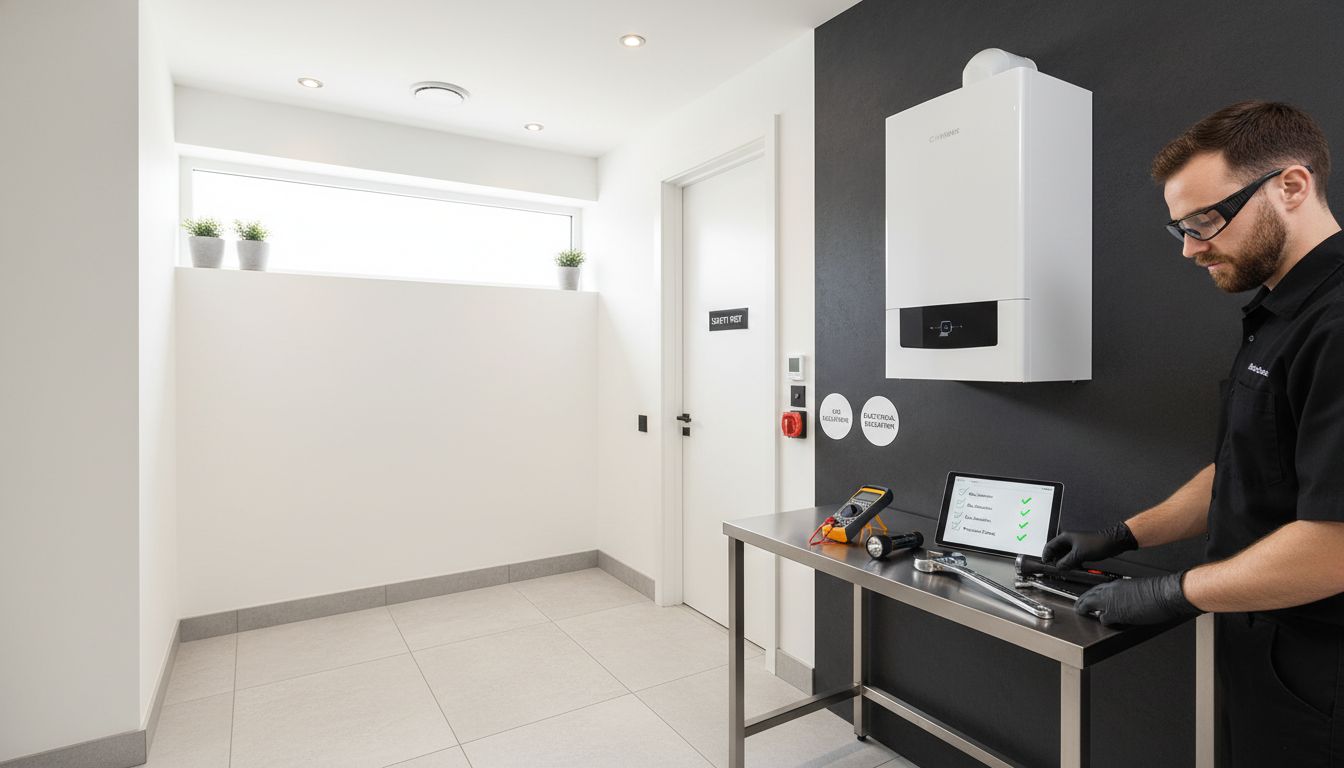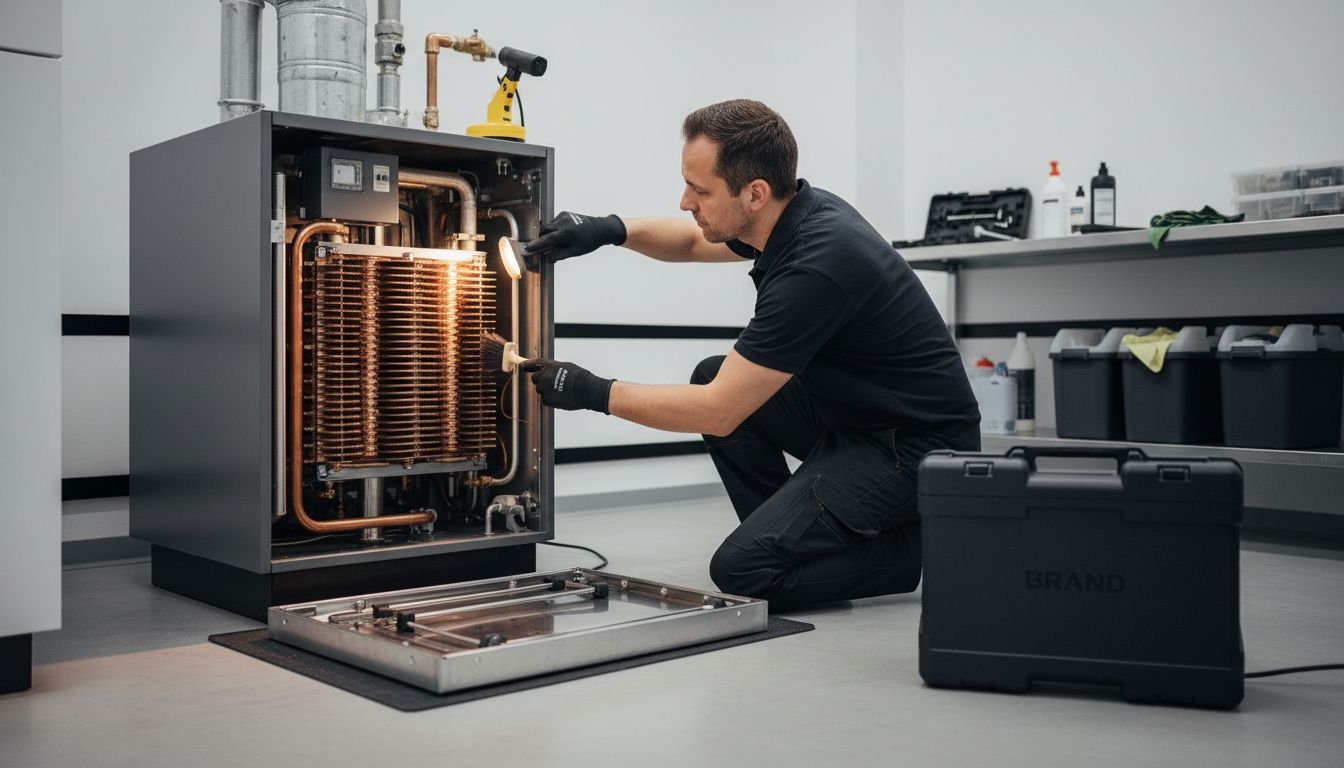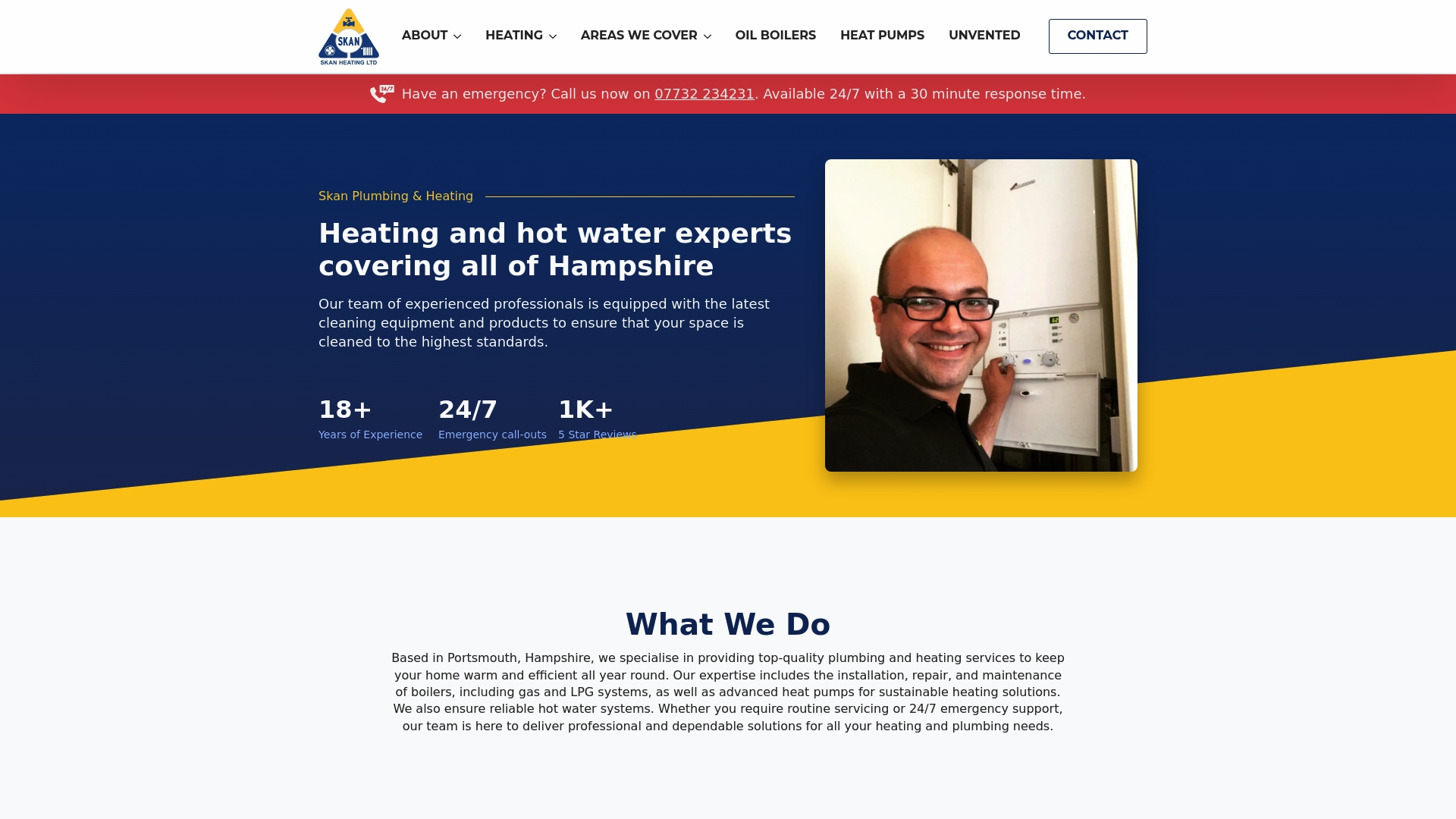Have an emergency? Call us now on 07732 234231. Available 24/7 with a 30 minute response time.

Did you know that boiler breakdowns spike by up to 20 percent during colder months? Keeping your heating system in top shape can save you from unexpected costs and chilly surprises. Proper boiler maintenance not only lowers the risk of dangerous malfunctions but also extends your system’s life. Follow a step by step guide to make your heating safer, more reliable, and ready for any season.
| Key Point | Explanation |
|---|---|
| 1. Prepare Tools and Power Down | Gather necessary tools and safely disconnect power and gas to prevent accidents during maintenance. |
| 2. Inspect and Clean Components | Visually examine the boiler for damage and clean critical parts to ensure optimal performance and longevity. |
| 3. Check for Leaks and Corrosion | Carefully look for leaks and corrosion which can lead to system failure if not addressed promptly. |
| 4. Test Controls and Safety Devices | Verify functioning of pressure gauges and safety devices before turning the system back on to ensure safety. |
| 5. Restart and Verify Performance | Restart the boiler and monitor its operation to confirm everything is working correctly and efficiently. |
Safety starts with proper preparation when maintaining your boiler system. In this crucial first step, you will gather the right tools and carefully power down your boiler to prevent potential accidents or damage during maintenance.
First, collect all necessary safety equipment and tools before beginning. You will need protective gloves, safety glasses, a multimeter, screwdrivers, adjustable wrench, and a torch for clear visibility. According to the essential boiler maintenance guide, having these items ready prevents interruptions during your maintenance process.
To power down the boiler safely, locate your electrical isolation switch typically positioned near the boiler or on a separate wall panel. Turn this switch to the off position to completely disconnect electrical power. Next, shut off the gas supply using the main gas valve. These actions prevent any potential electrical or gas hazards while working on your heating system.
Warning: Never attempt boiler maintenance without first cutting power and gas supply completely.
If your boiler is connected to a timer or smart home system, ensure these are also deactivated to prevent unexpected restarting. Take a moment to allow the boiler to cool down completely before proceeding with further inspection or maintenance tasks.
By methodically preparing your workspace and powering down the system, you are setting the foundation for a safe and effective boiler maintenance process. The next step will involve carefully inspecting the boiler for any visible signs of wear or damage.
With the boiler safely powered down, you are now ready to conduct a thorough inspection and cleaning of its critical components. According to the comprehensive boiler servicing guide, regular inspection prevents potential breakdowns and maintains optimal system performance.
Begin by visually examining the exterior of the boiler for any signs of corrosion, rust, or water leakage. Pay close attention to pipe connections, seals, and the casing. The ECO3 Boiler Assessment Checklist recommends checking for discoloration or moisture accumulation that might indicate underlying issues.
Carefully remove the boiler casing using appropriate tools carefully. Look for dust buildup, soot, or debris around heat exchangers, burners, and internal components. Use a soft brush and compressed air to gently clean these areas, avoiding direct contact with electrical parts. Ensure all components appear clean and undamaged.

Warning: If you observe significant corrosion or damage, contact a professional heating engineer for expert assessment.
Inspect the heat exchanger for scale deposits or mineral buildup which can reduce heating efficiency. Check ignition leads and electrodes for wear or damage. Clean these components gently using manufacturer recommended methods to prevent potential system malfunctions.
By meticulously examining and cleaning your boiler components, you are taking proactive steps to ensure reliable heating performance and extend your system’s operational lifespan. The next step will involve checking and testing specific mechanical and electrical connections.
As you progress through your boiler maintenance, identifying potential leaks and corrosion becomes crucial for preventing significant system damage. According to the essential boiler servicing guide, early detection of these issues can save you from costly repairs and potential system failure.
Begin by carefully examining all visible piping connections and seals. The ECO3 Boiler Assessment Checklist recommends looking for telltale signs of moisture such as water stains, rust marks, or mineral deposits around pipe joints and valve connections. Run your hand gently along pipes and connections to feel for any dampness that might indicate a slow leak.
Pay special attention to the areas around pipe fittings, pressure relief valves, and the base of the boiler. Corrosion often appears as reddish brown or white powdery deposits on metal surfaces. Check for any flaking paint, unusual discoloration, or areas where metal seems to be breaking down or showing signs of oxidation.
Warning: Small leaks can quickly escalate into major system problems if left unaddressed.
Use a bright torch to illuminate dark or hard to see areas. Look for subtle signs of water damage such as slight discoloration of surrounding materials or minimal rust spots. If you notice any significant corrosion or persistent moisture that suggests an active leak, it is recommended to contact a professional heating engineer for a comprehensive assessment.
Carefully document any areas of concern with photographs. This documentation can be valuable for tracking changes over time or providing information to a professional technician. By methodically checking for leaks and corrosion, you are taking proactive steps to maintain your boiler system’s integrity and performance. The next step will involve testing system pressure and electrical connections.
With your boiler carefully prepared, you now enter a critical phase of maintenance checking the essential controls and safety mechanisms. Understanding boiler servicing reveals the importance of systematic testing to prevent potential system failures.
Start by examining the pressure gauge. According to the ECO3 Boiler Assessment Checklist, your boiler should maintain pressure between 1 and 1.5 bar when cold. If the pressure appears too low or too high, this could indicate underlying issues with your system that require further investigation.
Next, test the temperature controls. Activate your thermostat and observe how the boiler responds. Check that the temperature settings adjust smoothly and the boiler ignites and shuts off appropriately. Pay close attention to any unusual delays or inconsistent performance that might suggest control mechanism problems.
Warning: Unusual control behaviour could signal potential safety risks and should not be ignored.
Carefully inspect safety devices such as the pressure relief valve and thermal cut out switch. These components protect your system from overheating or excessive pressure buildup. Verify they are free from corrosion and respond correctly during simulated stress conditions. If you notice any signs of wear or irregular functioning, professional assessment becomes crucial.
Documenting your observations provides valuable information for potential future servicing.
By methodically testing these critical controls, you are ensuring your boiler operates safely and efficiently. The next step will involve checking electrical connections and preparing for system restart.
You have reached the final stage of your boiler maintenance process where careful restart and performance verification become crucial. Boiler servicing best practices emphasize the importance of systematic recommissioning to ensure optimal system functionality.
Begin by systematically restoring power and gas supply to the boiler. Switch on the electrical isolation switch and carefully reopen the main gas valve. Observe the boiler carefully during initial startup to ensure smooth ignition and consistent operation.
According to the ECO3 Boiler Assessment Checklist, watch for steady flame appearance and listen for any unusual sounds that might indicate potential mechanical issues.
Activate your heating system and monitor temperature performance across different settings. Check that radiators warm up evenly and the boiler responds promptly to thermostat adjustments. Pay attention to water pressure stabilisation and ensure it remains within the recommended 1 to 1.5 bar range during operation.
Warning: Persistent unusual noises or erratic performance warrant immediate professional assessment.
Conduct a comprehensive operational test by running the heating system for at least 15 minutes. Verify that all safety controls function correctly and the system maintains consistent temperature without unexpected shutdowns or pressure fluctuations. Take note of any performance variations that might require further investigation.
By methodically verifying your boiler performance, you have completed a thorough maintenance process that helps prevent potential future breakdowns and ensures efficient heating system operation. Regular professional servicing remains recommended for long term system reliability.
Here’s an overview of tools, checks, and safety points for each boiler maintenance step:
| Step | Main Tasks | Tools/Equipment | Key Safety Focus |
|---|---|---|---|
| Prepare & Power Down | Gather tools Switch off power/gas | Gloves Safety glasses Multimeter | Isolate electric & gas supply |
| Inspect & Clean Components | Visual inspection Dust removal | Torch Soft brush Compressed air | Avoid electrical contact |
| Check for Leaks/Corrosion | Examine pipes Check for moisture | Torch Camera (for records) | Identify leaks early |
| Test Controls & Safety Devices | Pressure & thermostat testing | Pressure gauge | Ensure correct operation |
| Restart & Verify Performance | Turn on power/gas Monitor heating | None specific | Observe start-up safely |
Regular boiler maintenance is essential for avoiding leaks, pressure issues, and unsafe operation. If you feel overwhelmed by checking pressure gauges or suspect corrosion and electrical faults, you are not alone. Many homeowners and businesses in Hampshire face these challenges when trying to maintain safe and reliable heating. Our step-by-step guide clearly highlights common pain points such as power isolation, component cleaning, and testing safety devices — important tasks that require skill and precision.
Do not risk costly repairs or unsafe conditions by delaying professional support. Skan Heating brings over 18 years of trusted experience in boiler installation, servicing, and emergency repairs, ensuring your heating system operates smoothly all year round. Whether you need urgent fault fixes or routine servicing, our certified technicians in Portsmouth and Waterlooville are available 24/7 for your peace of mind.

Ensure safe heating today. Visit Skan Heating to book a service or arrange an emergency call out and benefit from reliable expertise tailored for your specific boiler needs. Stay warm and worry-free with professional care designed to protect your home or business.
To safely power down your boiler, turn off the electrical isolation switch and shut off the gas supply at the main gas valve. Ensure both power and gas are completely disconnected before proceeding with any maintenance tasks.
You will need protective gloves, safety glasses, a multimeter, screwdrivers, an adjustable wrench, and a torch for visibility. Gather these tools before you start to avoid interruptions during your maintenance process.
Examine all visible piping, connections, and the boiler base for signs of moisture, rust, or discoloration. Feel the pipe fittings and valves for dampness, and document any issues you find to address them promptly.
If you observe significant corrosion or damage, contact a professional heating engineer for an expert assessment. Promptly addressing these issues can prevent costly repairs and system failures.
Start by examining the pressure gauge and checking that the boiler maintains pressure between 1 and 1.5 bar when cold. Activate the thermostat to test temperature controls, ensuring the boiler ignites and operates correctly without unusual delays.
After restarting your boiler, monitor its operation for at least 15 minutes. Check for steady flame appearance, consistent heating, and no unusual noises, ensuring all safety controls function properly before considering the maintenance complete.